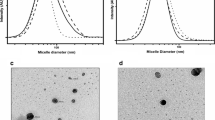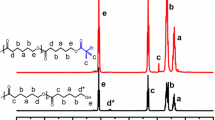ABSTRACT
Purpose
PEG-phospholipid-based micelles have been successfully used for the solubilization of several hydrophobic drugs but generally lack sustained stability in blood. Our novel PEG-Fluorocarbon-DSPE polymers were designed to increase stability and improve time-release properties of drug-loaded micelles.
Methods
Novel ABC fluorous copolymers were synthesized, characterized, and used for encapsulation release of amphotericin B. FRET studies were used to study micelle stability.
Results
The micelles formed by the new polymers showed lower critical micelle concentrations and higher viscosity cores than those formed by the polymers lacking the fluorous block. FRET studies indicated that fluorocarbon-containing micelles had increased stability in presence of human serum. Physicochemical properties and in vitro release profile of micelles loaded with Amphotericin B (AmB) were studied.
Conclusions
The effect of PEG length and fluorocarbon incorporation were investigated. The shorter hydrophilic PEG2K induced greater stability than PEG5K by decreasing the proportion of hydrophilic block of the polymer. The fluorocarbon placed between hydrophilic and hydrophobic block formed a fluorous shell contributing to the enhanced thermodynamic stability of micelles and to the drug sustained release. Polymer mPEG2K-F10-DSPE, bearing both a fluorocarbon block and a shorter mPEG, showed the greatest stability and the longest half-life for AmB release.







Similar content being viewed by others
Abbreviations
- AmB:
-
Amphotericin B
- CMC:
-
critical micelle concentration
- DiIC18(3):
-
1,1-dioctadecyl-3,3,3,3-tetramethylindocarbocyanine perchlorate
- DiOC18(3):
-
3,3-dioctadecyloxacarbocyanine perchlorate
- DSPE:
-
1,2-distearoyl-sn-glycero-3-phosphoethanolamine
- FRET:
-
Förster resonance energy transfer
- mPEG:
-
methoxy-capped poly(ethylene glycol)
- P3P:
-
1,3-(1,1′-dipyrenyl) propane
- PEG:
-
poly(ethylene glycol)
- PEG2K:
-
poly(ethylene glycol) of an average molecular weight of 2,000
- PEG5K:
-
poly(ethylene glycol) of an average molecular weight of 5,000
REFERENCES
Singh S, Dash AK. Paclitaxel in cancer treatment: perspectives and prospects of its delivery challenges. Crit Rev Ther Drug Carrier Syst. 2009;26(4):333–72.
Yoon HJ, Jang WD. Polymeric supramolecular systems for drug delivery. J Mater Chem. 2010;20(2):211–22.
Allen TM, Hansen C, Martin F, Redemann C, Yauyoung A. Liposomes containing synthetic lipid derivatives of poly(ethylene glycol) show prolonged circulation half-lives invivo. Biochim Biophys Acta. 1991;1066(1):29–36.
Ashok B, Arleth L, Hjelm RP, Rubinstein I, Onyuksel H. In vitro characterization of PEGylated phospholipid micelles for improved drug solubilization: effects of PEG chain length and PC incorporation. J Pharm Sci. 2004;93(10):2476–87.
Gabizon AA, Barenholz Y, Bialer M. Prolongation of the circulation time of doxorubicin encapsulated in liposomes containing a polyethylene glycol-derivatized phospholipid—pharmacokinetic studies in rodents and dogs. Pharm Res. 1993;10(5):703–8.
Lukyanov AN, Torchilin VP. Micelles from lipid derivatives of water-soluble polymers as delivery systems for poorly soluble drugs. Adv Drug Deliv Rev. 2004;56(9):1273–89.
Torchilin VP. Structure and design of polymeric surfactant-based drug delivery systems. J Control Release. 2001;73(2–3):137–72.
Chen H, Kim S, He W, Wang H, Low PS, Park K, et al. Fast release of lipophilic agents from circulating PEG-PDLLA micelles revealed by in vivo Forster resonance energy transfer imaging. Langmuir. 2008;24(10):5213–7.
Savic R, Azzam T, Eisenberg A, Maysinger D. Assessment of the integrity of poly(caprolactone)-b-poly(ethylene oxide) micelles under biological conditions: a fluorogenic-based approach. Langmuir. 2006;22(8):3570–8.
Xu XY, Zhang XF, Wang XH, Li YX, Jing XB. Comparative study of paclitaxel physically encapsulated in and chemically conjugated with PEG-PLA. Polym Adv Technol. 2009;20(11):843–8.
Bae KH, Lee Y, Park TG. Oil-encapsulating PEO-PPO-PEO/PEG shell cross-linked nanocapsules for target-specific delivery of paclitaxel. Biomacromolecules. 2007;8(2):650–6.
O’Reilly RK, Hawker CJ, Wooley KL. Cross-linked block copolymer micelles: functional nanostructures of great potential and versatility. Chem Soc Rev. 2006;35(11):1068–83.
Shuai XT, Merdan T, Schaper AK, Xi F, Kissel T. Core-cross-linked polymeric micelles as paclitaxel carriers. Bioconjug Chem. 2004;15(3):441–8.
Xu YM, Meng FH, Cheng R, Zhong ZY. Reduction-sensitive reversibly crosslinked biodegradable micelles for triggered release of doxorubicin. Macromol Biosci. 2009;9(12):1254–61.
Tian L, Yam L, Wang JZ, Tat H, Uhrich KE. Core crosslinkable polymeric micelles from PEG-lipid amphiphiles as drug carriers. J Mater Chem. 2004;14(14):2317–24.
Kiss LE, Kovesdi I, Rabai J. An improved design of fluorophilic molecules: prediction of the ln P fluorous partition coefficient, fluorophilicity, using 3D QSAR descriptors and neural networks. J Fluor Chem. 2001;108(1):95–109.
Riess JG. Highly fluorinated amphiphilic molecules and self-assemblies with biomedical potential. Curr Opin Colloid Interface Sci. 2009;14(5):294–304.
Wolfson MR, Greenspan JS, Shaffer TH. Pulmonary administration of vasoactive substances by perfluorochemical ventilation. Pediatrics. 1996;97(4):449–55.
Kent KM, Cleman MW, Cowley MJ, Forman MB, Jaffe CC, Kaplan M, et al. Reduction of myocardial-ischemia during percutaneous transluminal coronary angioplasty with oxygenated fluosol. Am J Cardiol. 1990;66(3):279–84.
Spahn DR, van Brempt R, Theilmeier G, Reibold JP, Welte M, Heinzerling H, et al. European perflubron emulsion study, G., Perflubron emulsion delays blood transfusions in orthopedic surgery. Anesthesiology. 1999;91(5):1195–208.
Krafft MP. Fluorocarbons and fluorinated amphiphiles in drug delivery and biomedical research. Adv Drug Deliv Rev. 2001;47(2–3):209–28.
Janjic JM, Ahrens ET. Fluorine-containing nanoemulsions for MRI cell tracking. Wiley Interdiscip Rev Nanomed Nanobiotechnol. 2009;1(5):492–501.
Shao K, Huang RQ, Li JF, Han LA, Ye LY, Lou JN, et al. Angiopep-2 modified PE-PEG based polymeric micelles for Amphotericin B delivery targeted to the brain. J Control Release. 2010;147(1):118–26.
Vakil R, Knilans K, Andes D, Kwon GS. Combination antifungal therapy involving Amphotericin B, rapamycin and 5-fluorocytosine using PEG-phospholipid micelles. Pharm Res. 2008;25(9):2056–64.
Vakil R, Kwon GS. Effect of cholesterol on the release of Amphotericin B from PEG-Phospholilpid micelles. Mol Pharm. 2008;5(1):98–104.
Gallis HA, Drew RH, Pickard WW. Amphotericin-B - 30 years of clinical-experience. Rev Infect Dis. 1990;12(2):308–29.
Girois SB, Chapuis F, Decullier E, Revol BGP. Adverse effects of antifungal therapies in invasive fungal infections: review and meta-analysis. Eur J Clin Microbiol Infect Dis. 2005;24(2):119–30.
Barwicz J, Tancrede P. The effect of aggregation state of amphotericin-B on its interactions with cholesterol- or ergosterol-containing phosphatidylcholine monolayers. Chem Phys Lipids. 1997;85(2):145–55.
Brajtburg J, Bolard J. Carrier effects on biological activity of Amphotericin B. Clin Microbiol Rev. 1996;9(4):512–31.
Bolard J, Legrand P, Heitz F, Cybulska B. One-sided action of amphotericin-B on cholesterol-containing membranes is determined by its self-association in the medium. Biochemistry. 1991;30(23):5707–15.
Gruda I, Dussault N. Effect of the aggregation state of Amphotericin-B on its interaction with ergosterol. Biochem Cell Biol-Biochimie Biol Cell. 1988;66(3):177–83.
Groll AH, Giri N, Petraitis V, Petraitiene R, Candelario M, Bacher JS, et al. Comparative efficacy and distribution of lipid formulations of Amphotericin B in experimental Candida albicans infection of the central nervous system. J Infect Dis. 2000;182(1):274–82.
Imhof A, Walter RB, Schaffner A. Continuous infusion of escalated doses of Amphotericin B deoxycholate: an open-label observational study. Clin Infect Dis. 2003;36(8):943–51.
Eriksson U, Seifert B, Schaffner A. Comparison of effects of Amphotericin B deoxycholate infused over 4 or 24 hours: randomised controlled trial. Br Med J. 2001;322(7286):579–82.
Peleg AY, Woods ML. Continuous and 4 h infusion of Amphotericin B: a comparative study involving high-risk haematology patients. J Antimicrob Chemother. 2004;54(4):803–8.
Hiemenz JW. Amphotericin B deoxycholate administered by continuous infusion: does the dosage make a difference? Clin Infect Dis. 2003;36(8):952–3.
Bates DW, Su L, Yu DT, Chertow GM, Seger DL, Gomes DRJ, et al. Mortality and costs of acute renal failure associated with Amphotericin B therapy. Clin Infect Dis. 2001;32(5):686–93.
Abla M, Durand G, Pucci B. Glucose-based surfactants with hydrogenated, fluorinated, or hemifluorinated tails: synthesis and comparative physical-chemical characterization. J Org Chem. 2008;73(21):8142–53.
Lavasanifar A, Samuel J, Kwon GS. The effect of alkyl core structure on micellar properties of poly(ethylene oxide)-block-poly(L-aspartamide) derivatives. Colloids Surf B Biointerfaces. 2001;22(2):115–26.
Winnik FM. Photophysics of preassociated pyrenes in aqueous polymer-solutions and in other organized media. Chem Rev. 1993;93(2):587–614.
Vakil R, Kwon GS. Poly(ethylene glycol)-b-poly(epsilon-caprolactone) and PEG-phospholipid form stable mixed micelles in aqueous media. Langmuir. 2006;22(23):9723–9.
Kim SY, Shin ILG, Lee YM, Cho CS, Sung YK. Methoxy poly(ethylene glycol) and epsilon-caprolactone amphiphilic block copolymeric micelle containing indomethacin. II. Micelle formation and drug release behaviours. J Control Release. 1998;51(1):13–22.
Francis MF, Lavoie L, Winnik FM, Leroux JC. Solubilization of cyclosporin A in dextran-g-polyethyleneglycolalkyl ether polymeric micelles. Eur J Pharm Biopharm. 2003;56(3):337–46.
Jeong YI, Cheon JB, Kim SH, Nah JW, Lee YM, Sung YK, et al. Clonazepam release from core-shell type nanoparticles in vitro. J Control Release. 1998;51(2–3):169–78.
Riess JG. Fluorous micro- and nanophases with a biomedical perspective. Tetrahedron. 2002;58(20):4113–31.
Sadtler VM, Giulieri F, Krafft MP, Riess JG. Micellization and adsorption of fluorinated amphiphiles: questioning the 1CF(2)approximate to 1.5CH(2) rule. Chemistry-a European Journal. 10;4:1952–6.
Kissa E. Fluorinated surfactants: synthesis, properties, applications, vol. 50. New York: M. Dekker; 1994.
Graciani MD, Rodriguez A, Munoz M, Moya ML. Micellar solutions of sulfobetaine Surfactants in water-ethylene glycol mixtures: surface tension, fluorescence, spectroscopic, conductometric, and kinetic studies. Langmuir. 2005;21(16):7161–9.
Diezi TA, Bae Y, Kwon GS. Enhanced stability of PEG-block-poly(N-hexyl stearate L-aspartamide) Micelles in the Presence of Serum Proteins. Mol Pharm. 2010;7(4):1355–60.
Vakil R, Kwon GS. PEG-phospholipid micelles for the delivery of Amphotericin B. J Control Release. 2005;101(1–3):386–9.
Mukerjee P. Fluorocarbon hydrocarbon interactions in micelles and other lipid assemblies, at interfaces, and in solutions. Colloid Surface Physicochem Eng Aspect). 1994;84(1):1–10.
Soo PL, Luo LB, Maysinger D, Eisenberg A. Incorporation and release of hydrophobic probes in biocompatible polycaprolactone-block-poly(ethylene oxide) micelles: implications for drug delivery. Langmuir. 2002;18(25):9996–10004.
Shuai XT, Ai H, Nasongkla N, Kim S, Gao JM. Micellar carriers based on block copolymers of poly(e-caprolactone) and poly(ethylene glycol) for doxorubicin delivery. J Contr Release. 2004;98(3):415–26.
Forrest ML, Won CY, Malick AW, Kwon GS. In vitro release of the mTOR inhibitor rapamycin from poly(ethylene glycol)-b-poly(epsilon-caprolactone) micelles. J Contr Release. 2006;110(2):370–7.
Lasic DD, Martin FJ. Stealth liposomes. Boca Raton: CRC; 1995.
Torchilin VP, Shtilman MI, Trubetskoy VS, Whiteman K, Milstein AM. Amphiphilic vinyl-polymers effectively prolong liposome circulation time in-vivo. Biochim Biophys Acta-Biomembr. 1994;1195(1):181–4.
Lukyanov AN, Gao ZG, Mazzola L, Torchilin VP. Polyethylene glycol-diacyllipid micelles demonstrate increased acculumation in subcutaneous tumors in mice. Pharm Res. 2002;19(10):1424–9.
Gabizon A, Shmeeda H, Barenholz Y. Pharmacokinetics of pegylated liposomal doxorubicin - Review of animal and human studies. Clin Pharmacokinet. 2003;42(5):419–36.
Maruyama K, Yuda T, Okamoto A, Ishikura C, Kojima S, Iwatsuru M. Effect of molecular-weight in amphipathic polyethyleneglycol on prolonging the circulation time of large unilamellar liposomes. Chem Pharm Bull. 1991;39(6):1620–2.
Liu F, Liu D. Long-circulating emulsions (oil-in-water) as carriers for lipophilic drugs. Pharm Res. 1995;12(7):1060–4.
ACKNOWLEDGMENTS & DISCLOSURES
The authors would like to thank Dr. Glen S. Kwon and Thomas A. Diezi, University of Wisconsin, for technical advice and thoughtful suggestions. This project was supported in part by NIH (GM079375) and NSF (CHE 0518112) to SM. We also thank the University of Wisconsin-Madison School of Pharmacy for support. JPJ acknowledges support from the Korean Research Foundation (KRF-2008-357-E00065).
Author information
Authors and Affiliations
Corresponding author
Rights and permissions
About this article
Cite this article
Jee, JP., McCoy, A. & Mecozzi, S. Encapsulation and Release of Amphotericin B from an ABC Triblock Fluorous Copolymer. Pharm Res 29, 69–82 (2012). https://doi.org/10.1007/s11095-011-0511-9
Received:
Accepted:
Published:
Issue Date:
DOI: https://doi.org/10.1007/s11095-011-0511-9




